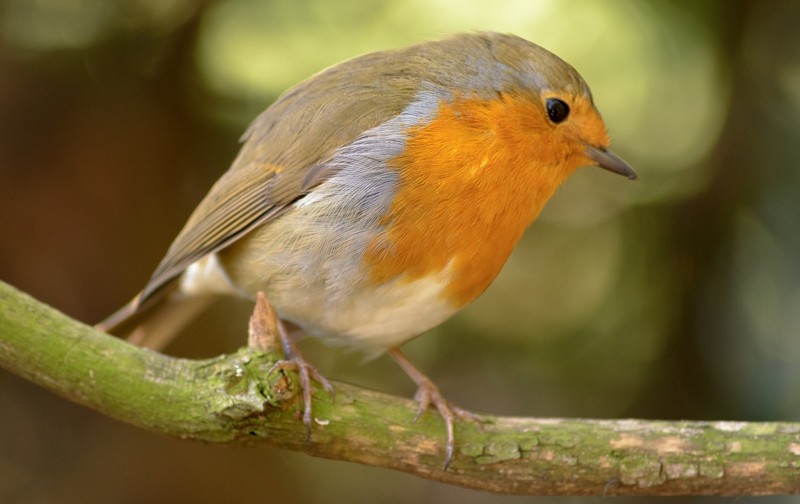Il Pettirosso Posted by Serena on Mar 29, 2018 in Uncategorized
Why does the Robin have red feathers on its breast? An Easter legend explains:
Un giorno di duemila anni fa, una mamma uccello stava volando in cerca di cibo per i suoi piccoli quando notò sulla cima di un colle tre croci con tre uomini appesi. Incuriosita l’uccellino si avvicinò e notò che uno di loro aveva una corona di spine in testa, e che una spina gli si era conficcata nella fronte e lo faceva sanguinare.
One day, two thousand years ago, a mother bird was flying in search of food for her little ones when she saw, on the top of a hill, three crosses with men hanging from them. Curious, the little bird drew closer and noticed that one of them had a crown of thorns on his head, and that a thorn had pierced his forehead, causing it to bleed.
La mamma uccello provò pietà per quest’uomo dallo sguardo buono e decise di rimuovere la spina che lo feriva. Col suo piccolo becco lavorò a lungo e alla fine ci riuscì, ma quando estrasse la spina dalla fronte, una goccia di sangue sprizzò sul petto dell’uccellino macchiandolo di rosso. Allora Gesù, grato per il gesto pietoso della mamma uccello, le disse: “In ricordo del tuo atto caritatevole, il tuo petto e il petto dei tuoi figli rimarrà per sempre rosso e sarete chiamati Pettirosso”.
The mother bird felt pity for the kind looking man, and decided to remove the thorn that was wounding him. With her little beak, she worked for a long time until she finally succeeded, but when she pulled the thorn from Christ’s forehead a drop of blood splashed onto the little bird’s breast, staining it red. Then Jesus, grateful for the mother bird’s kind gesture, said to her: “In memory of your charitable act, your breast and the breasts of your children will stay forever red, and you’ll be called Redbreast”.
Così il pettirosso diventò un simbolo pasquale, come in questa poesia del poeta toscano Enrico Pea (Seravezza 1881 – Forte dei Marmi 1958):
Il Pettirosso, di Enrico Pea (English translation by Serena and Geoff)
Il pettirosso, ch’è di me più saggio,
non si lamenta se il raccolto è scarso,
se la neve ha coperto le campagne,
se l’acqua s’è gelata alla sua sede
e se il vento stentegna il suo ricetto.
The robin, who is wiser than me,
doesn’t complain if the harvest is scarce,
if the snow has covered the fields,
if the water has frozen in its place,
and if the wind shakes its shelter.
Dopo l’annata magra ecco che viene
l’abbondanza nell’aria e dopo il verno
il ruscello ricanta, il vento è brezza,
al pettirosso dolce ninna nanna.
After a poor year, here comes
abundance in the air, and after the winter
the stream sings again, wind becomes breeze,
a sweet lullaby for the Robin.
Il pettirosso, ch’è innocente e bello
sa che la Provvidenza lo sostenta,
sa che chi pate è poi racconsolato,
conosce il sangue, il pianto e la speranza
come ogni creatura che si lagna,
ma non conosce la disperazione.
The Robin, who is innocent and beautiful,
knows that Providence supports it,
knows that he who suffers will be consoled,
knows blood, tears and hope
as does every creature who laments,
but knows not desperation.
Il pettirosso che porta le insegne
di Cristo sul candore del suo seno,
che fu presente al pianto di Maria
quando la terra si coprì di nubi,
l’augellino prescelto a colorirsi
d’una stilla di sangue di Gesù,
vive, paziente, d’ogni Provvidenza,
sicuro aspetta, spera, crede e canta,
si specchia al cielo che gli pare suo!
The Robin, who carries the signs
of Christ on his immaculate chest,
who witnessed Mary’s tears
when the Earth clouded over,
the bird chosen to be stained
with a drop of Jesus’ blood,
lives, patient, ready for providence,
confidently waits, hopes, trusts and sings,
reflected in the sky that he believes his own!
Buona Pasqua!

Build vocabulary, practice pronunciation, and more with Transparent Language Online. Available anytime, anywhere, on any device.





Comments:
Rita Kostopoulos:
Vi auguro una felice e Santa Pasqua. Mille grazie per tutto.
Mike Nicolucci:
Ciao, vi ho mandato un messaggio utilizzando il “Contact”. Se non arrivasse, fatemi sapere. Mikenicolucci@gmail.com
Gianna Shaw:
Scusa perché si dice ‘petti’ e non ‘petto’ rosso?
Auguri per S. Pasqua
Serena:
@Gianna Shaw Salve Gianna! Non so perché si dica ‘pettirosso’ invece di ‘pettorosso’. C’è un altro uccello chiamato ‘codirosso’, invece di codarossa. Non ho trovato alcuna spiegazione, mi dispiace.
Saluti da Serena
Rosalind:
Nella lingua còrsa, abbiamo la stessa forma anche per persone :
Una capibionda (a girl or woman with fair hair)
Hè nasilongu/anchistortu (he has a long nose/ crooked legs)
The noun part always ends in “i” and the adjective part agrees with the person/animal concerned.
Often I find a usage which has modernised itself in Italian but not in Corsican
Serena:
@Rosalind Grazie Rosalind!